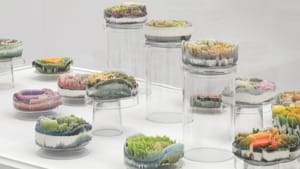Stay in the Loop
BSR publishes on a weekly schedule, with an email newsletter every Wednesday and Thursday morning. There’s no paywall, and subscribing is always free.
Nature plus
Brandywine Museum of Art's 'Natural Wonders: The Sublime in Contemporary Art'

On one wall are Maya Lin’s “lakes” of molten silver. Across the gallery are lenticular photographs by T.J. Wilcox that shift as you walk by. It’s not Philadelphia or New York. This exhibition is the artfully conceived Natural Wonder: The Sublime in Contemporary Art, in Chadds Ford, Pennsylvania, at the restored riverside gristmill that houses the Brandywine Museum of Art.
"Pleasurable peril"
Assembled by guest curator Suzanne Ramljak, the show is a stunner, gathering more than 40 pieces by 13 major American artists whose work proves that sublimity both provokes and soothes. Created with materials from the old-fashioned to the technologically new, these works comfort even as they disconcert.
The exhibition’s signature piece hangs outside the gallery: Kathleen Vance’s 25-foot-long recreation of the Brandywine River in the Museum’s soaring atrium. Complete with running water, it’s perched precariously in the air, a miniature world accessible and yet dangerously fragile.
That dichotomy is one of the exhibition’s messages. Ramljak calls the sublime “a region of pleasurable peril.” These works can be viewed as homages to nature. But each is also freighted with wonder, tinged or tainted by the technology that allows for these artists’ interpretations.
Vance also has work inside the gallery. Her three Travelling Landscapes, miniature worlds inside antique trunks, are based on Maryland countryside. Overtly charming, their snaking electrical cords and water lines also raise questions. Can nature be enclosed? Who owns it?
The river runs through it
Brandywine and Hudson River artists have long painted vistas, but in the exhibition’s luscious catalog, Ramljak notes that they looked at eye level. Maya Lin can recreate her silver Long Island lakes or steel-pin Hudson River because technology enables her to view nature from above.
The exhibition is packed with mystery. Jennifer Trask created four exceptionally strong mixed-media works featuring delicately carved bone. And though Roxy Paine’s stunning stainless-steel tree looks realistic, it’s a sort of “Franken-tree,” an amalgam of many kinds of branches.
Grotto and Kiku, Lauren Fensterstock’s two large black installations, hang from the ceiling or grow from the floor. Created of both natural and artificial materials and referencing flowers and caves, they simultaneously invite and warn.

Even when not overtly visible, technology is paramount. Miljohn Ruperto and Ulrik Heltoft fabricated a series of dark, lush works that appear to be old photos. They are actually computer-generated 3-D models, photographed and printed using the historic silver-gelatin process.
Alongside Wilcox’s morphing clouds and sky (as Turner or Parrish could never imagine), there is Mark Tribe’s 24-hour, single-take moving picture, Balsam Lake Mountain Wild Forest. A “day-in-the-life” view of an enticing forest both familiar and foreign, it captures nature as it changes.
Nature tech
Diana Thater’s Road to Hana Two, a nine-monitor video wall that uses layered footage, scale shifts and extended time cycles, portrays the “painted forest” of Hawaiian rainbow eucalyptus trees, a natural phenomenon that seems almost unnatural.
Dustin Yellin makes creations only technology could enable — four constructions of sandwiched glass and resin. Only eight or nine inches deep, because of their intricate fabrication they seem to go on forever, filled with seemingly endless details.
Technology and nature morph clearly in Remote Sensing, Suzanne Anker’s 24 microlandscapes. They began as living material, photographed by the artist as it decayed. She then reconstructed them with a 3-D printer and inserted the constructions back into their petri dishes.
Viewed through tiny portholes, Patrick Jacobs’s mixed-media dioramas are made of materials both inert (paper, acrylic, plastic) and more malignant (slime mold, hair, and ash). At first lyrical, the monochrome Pink Forest turns menacing; Spiral — all soft tones of green, white, and peach — contains strangling vines that go to the vanishing point, perched on the edge of oblivion.
The design and installation of these eclectic works was itself a feat. Even the shadow-image title graphic at the exhibition’s entrance alludes to the mysteries inside.
Since his arrival in 2012, museum director Thomas Padon has gradually extended the museum’s scope while respecting its founders’ impetus and the work of its sister organization, the Brandywine Conservancy. Natural Wonders amply achieves its goal to “investigate the intersection of the natural and artificial realms, the wild and cultivated.”
You may be dazzled or even amused by the artists’ inventiveness and points of view. But set aside time to really think about these works. Their resonance also borders on the sublime, and looking into these worlds is worth the time.
What, When, Where
Natural Wonders: The Sublime in Contemporary Art. Through October 21, 2018, at the Brandywine Museum of Art, 1 Hoffman's Mill Road, Chadds Ford, Pennsylvania. (610) 388-2700 or brandywine.org.
Sign up for our newsletter
All of the week's new articles, all in one place. Sign up for the free weekly BSR newsletters, and don't miss a conversation.
 Gail Obenreder
Gail Obenreder